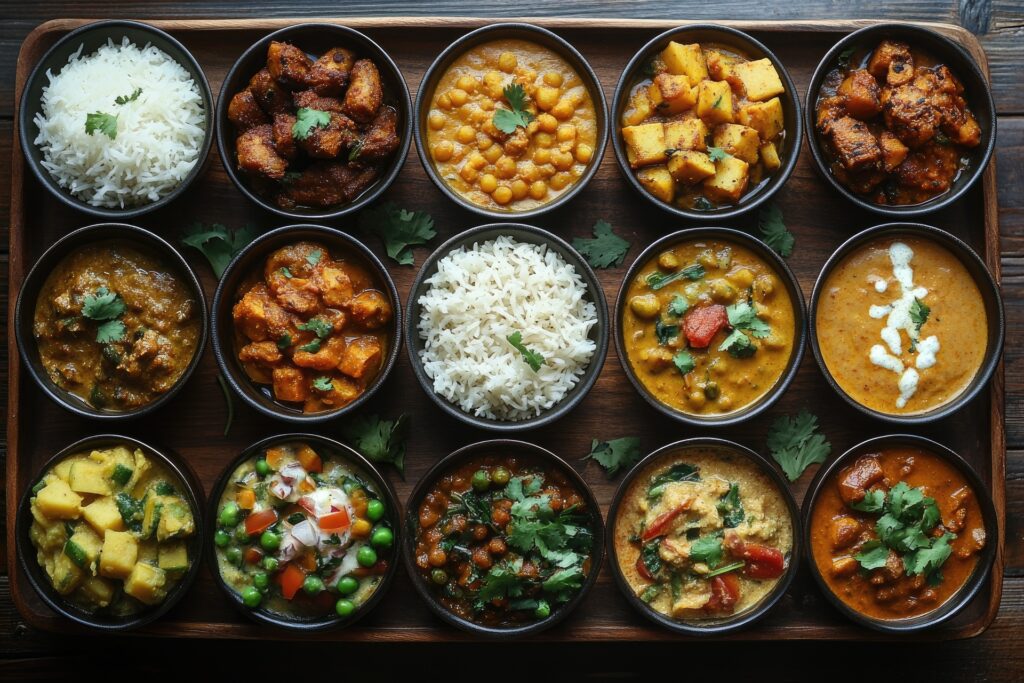
Indian cuisine is a symphony of flavours, textures, and traditions deeply rooted in the country’s history and geography. Each region tells its culinary story, shaped by climate, local ingredients, and cultural influences. North Indian and South Indian cuisines are distinct yet complementary culinary worlds.
Chef Abdul, a master of Indian gastronomy, often emphasises that to understand Indian food truly, one must appreciate the contrasts and connections between these culinary traditions. Explore North and South Indian cuisines, including their staples, spices, cooking techniques, and signature dishes.
The Staples: Wheat vs. Rice
The foundation of any cuisine is its staple grain, and here lies the first striking difference between North and South Indian cooking.
Chef Abdul notes, “The beauty of North Indian bread is their variety—each type has a unique texture and flavour, from the flaky parathas to the pillowy naans baked in a tandoor.”
Chef Abdul highlights, “Rice in South India isn’t just a side—it’s an essential part of the meal, whether it’s flavoured with lemon, tamarind, or coconut milk.”
Flavor Profiles: Creamy and Rich vs. Tangy and Spicy
Each region’s local ingredients and cooking traditions shape the flavour profiles of North and South Indian cuisines.
North Indian Flavors
North Indian cuisine is characterised by its richness, thanks to the liberal use of dairy products like cream, yoghurt, and ghee. Dishes often have a warm, aromatic flavour, with spices like cumin, coriander, and garam masala taking centre stage. Nuts and dried fruits are frequently incorporated, especially in Mughal-inspired dishes like biryanis and kormas.
Common Ingredients in North Indian Cooking:
Chef Abdul explains, “North Indian food reflects the region’s history, particularly the influence of Mughal cooking, which brought an indulgent richness to the cuisine.”
South Indian Flavors
South Indian cuisine is bold, tangy, and often lighter than its northern counterpart. The use of tamarind, curry leaves, and coconut defines its flavour. Mustard seeds, dried red chillies, and black pepper are frequently tempered in hot oil to release their aromas and add depth.
Common Ingredients in South Indian Cooking:
Chef Abdul describes South Indian cuisine as “a celebration of bold flavours and vibrant spices that dance on the palate.”
Signature Dishes of North India
Chef Abdul believes that the essence of North Indian cuisine lies in its hearty, satisfying dishes that are perfect for celebrations or comforting meals. Here are some must-try classics:
Paneer Butter Masala : This creamy tomato-based curry with soft paneer cubes is a favourite at every Indian restaurant. The butter and cream add a luxurious texture, while the hint of kasuri methi (dried fenugreek) brings subtle bitterness to balance the sweetness.
Chana Masala : Chickpeas are cooked in a spiced onion-tomato gravy flavoured with garam masala and amchur (dried mango powder). This high-protein dish is often served with bhature or steamed rice.
Aloo Paratha : A stuffed bread filled with spiced mashed potatoes, cooked on a hot griddle with ghee. It’s often enjoyed with yoghurt and pickles.
Vegetable Pulao : Aromatic basmati rice cooked with seasonal vegetables, whole spices, and saffron. It’s a lighter alternative to biryani but equally flavorful.
Signature Dishes of South India
South Indian cuisine offers a balance of flavours and textures, focusing on using fresh and wholesome ingredients. Chef Abdul often praises these dishes for their health benefits and versatility:
Masala Dosa : A crisp, golden crepe made from fermented rice and lentil batter filled with spiced mashed potatoes. It’s served with coconut chutney and sambar, making it a complete meal.
Sambar : A tangy lentil-based stew made with tamarind, vegetables, and a unique spice blend. It’s a staple accompaniment for rice, dosa, and idli.
Avial : A creamy dish of mixed vegetables cooked in coconut and yoghurt, tempered with curry leaves and mustard seeds. Originating from Kerala, it’s a perfect side for rice.
Rasam : A light, tangy soup made with tamarind, tomatoes, and black pepper, often served as a digestive at the end of a meal.
Cooking Techniques: Tandoor vs. Tempering
The culinary techniques of North and South India reflect the local environment and cooking traditions.
Chef Abdul often highlights how these techniques define the textures and flavours of Indian dishes, making them unique yet universally appealing.
Bringing North and South Indian Cuisine Into Your Kitchen
Chef Abdul shares his tips for exploring these culinary worlds at home:
A Culinary Journey with Chef Abdul
As Chef Abdul puts it, “North and South Indian cuisines are two sides of the same vibrant coin. Exploring their differences and connections is like travelling through India, one dish at a time.”
Whether you’re drawn to the creamy gravies of the North or the tangy coconut flavours of the South, both cuisines offer endless opportunities to savour the diversity of Indian cooking. Which one will you try first? The journey awaits!
Chef Abdul © Copyright 2024. All rights reserved.